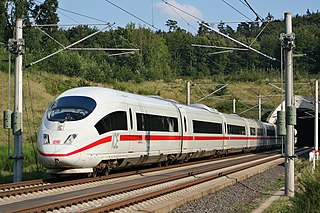
Intercity Express is a high-speed rail system in Germany. It also serves destinations in Austria, France, Belgium, Switzerland and the Netherlands as part of cross-border services. It is the flagship of the German state railway, Deutsche Bahn. ICE fares are fixed for station-to-station connections, on the grounds that the trains have a higher level of comfort. Travelling at speeds up to 320 km/h (200 mph), they are aimed at business travellers and long-distance commuters and marketed by Deutsche Bahn as an alternative to flights.
Die Länderbahn GmbH (DLB), formerly Vogtlandbahn GmbH, is a German rail transport company based in Viechtach, operating transport services originally only in the Vogtland, but now also on a regional basis. Die Länderbahn is a subsidiary of Regentalbahn AG, which is owned by Ferrovie dello Stato subsidiary Netinera. The term vogtlandbahn remains in use as a trademark of Die Länderbahn in Vogtland.

The approximately 5,400 railway stations in Germany that are owned and operated by the Deutsche Bahn subsidiary DB Station&Service are divided into seven categories, denoting the service level available at the station.
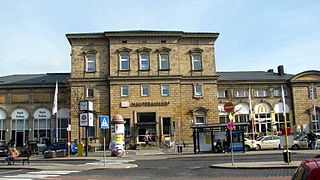
Bayreuth Hauptbahnhof is the main railway station in the German town of Bayreuth, in northern Bavaria.
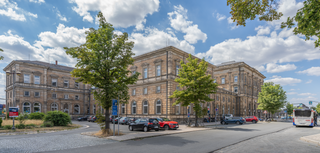
Hof Hauptbahnhof is the main railway station in Hof in southern Germany and is situated at the intersection of the Saxon-Franconian trunk line (Magistrale) and the Munich–Regensburg–Leipzig–Berlin line. When it was opened it formed the boundary between the former Bavarian Ludwig South-North Railway Lindau–Hof to the Saxon-Bavarian Railway on the Saxon side from Hof–Leipzig.
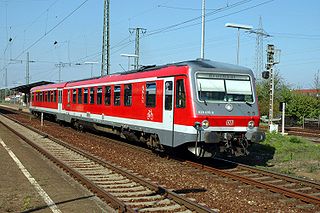
The DB Class 628 is a twin-car, diesel multiple unit operated by the Deutsche Bahn for local passenger rail services.
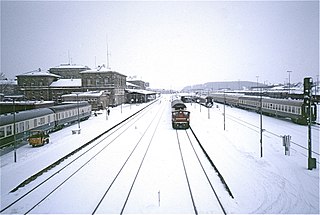
The Bamberg–Hof railway is a 127 kilometre-long main line that runs through Bavaria in southern Germany. The line runs from Bamberg via Lichtenfels, Kulmbach, Neuenmarkt-Wirsberg and Münchberg to Hof. The section from Hof to Neuenmarkt now forms part of the Saxon-Franconian trunk line.
DB Regio Oberfranken is a business area with the German national railway company, Deutsche Bahn, with its headquarters in Hof (Saale). It is responsible for the majority of regional and local railway services in the Bavarian province of Upper Franconia (Oberfranken).

The Interregio-Express (IRE) is a local public transport railway service operated by the Deutsche Bahn which is only available in the German states of Baden-Württemberg, Bavaria, Saxony, Saxony-Anhalt and Berlin as well as in Switzerland. The IRE service was first introduced in the 2001 summer timetable, due to the increasing abolition of Interregio routes by DB's long-distance division. As a result, several German states ordered InterRegioExpress trains on the routes affected. In addition IRE trains were also introduced on routes that had not previously had an Interregio service.
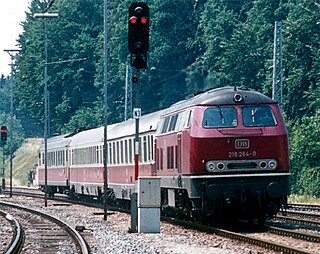
The Buchloe–Lindau railway is a double-track, largely non-electrified main line in the German state of Bavaria. It runs through the Allgäu from Buchloe to Lindau in Lake Constance via Kaufbeuren and Kempten. Together with the connecting Munich–Buchloe railway it is known in German as the Bayerische Allgäubahn.

The Bamberg–Rottendorf railway is a two-track electrified main line railway in the German state of Bavaria. It is about 100 kilometres long and was built by the Royal Bavarian State Railways as part of the Ludwig's Western Railway from Bamberg via Haßfurt and Schweinfurt to Würzburg. Between Bamberg and Schweinfurt, the line runs largely along the Main river. The line was opened in sections between 1852 and 1854 and is one of the oldest railways in Germany.

Saxon-Franconian trunk line is a modern term for a double-track railway route between the German cities of Dresden and Nuremberg. It is 390 kilometres long and currently electrified from Dresden to Hof. The concept of the Saxon-Franconian trunk route was developed in the transport policy debate in the 1990s during consideration of direct rail services connecting Dresden and Görlitz with Karlsruhe and Oberstdorf. The term is not traditionally used in relation to the railway lines now described by it.

The Nuremberg–Cheb railway is a 151 km long, non-electrified main line, mainly in the German state of Bavaria. It runs from Nuremberg via Lauf an der Pegnitz, Hersbruck, Pegnitz, Kirchenlaibach, Marktredwitz and Schirnding to Cheb in the Czech Republic. The route is also known as the RightPegnitz line or the Pegnitz Valley Railway (Pegnitztalbahn). It was built as the Fichtel Mountains Railway (Fichtelgebirgsbahn). The Nuremberg–Schnabelwaid section of it is part of the Saxon-Franconian trunk line (Sachsen-Franken-Magistrale).

The Schnabelwaid–Bayreuth railway is an 18.2 km long single-track main line from Schnabelwaid via Creußen to Bayreuth in the German state of Bavaria. It is part of the Saxon-Franconian trunk line.
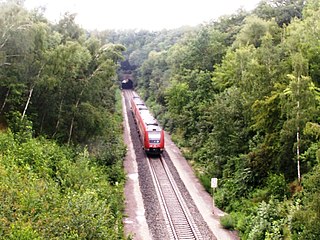
The Mid-Germany Railway is a rail link between German states of Thuringia and Saxony. The central element of this link connects Chemnitz and Glauchau in the east via Gera and Jena to Weimar in the west. It includes the Dresden–Werdau line, the Glauchau–Gößnitz line, the Gera–Gößnitz line and the Weimar–Gera line.
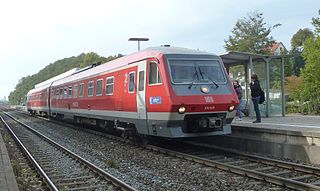
The DB Class 610 is a Diesel Multiple Unit (DMU) train type operated by the Deutsche Bahn in Germany. They were built from 1991 to 1992 by MAN and Duewag. The class uses a tilting Hydraulic Fiat system used in Italian Pendolino trains.

The Immenstadt–Oberstdorf railway is a non-electrified, single-track railway in the German state of Bavaria. The standard gauge line branches off the Buchloe–Lindau railway in Immenstadt and runs via Sonthofen to Oberstdorf. For its whole length it is in the district of Oberallgäu and follows the course of the Iller river. The branch line is operated by Deutsche Bahn. Together with the Neu-Ulm–Kempten railway, the line is also called the Iller Valley Railway. It is used by timetable routes 970 and 975.

Gößnitz station is a railway station on the Leipzig–Hof railway, the Glauchau–Gößnitz railway and the Gößnitz–Gera in Gößnitz in the German state of Thuringia.
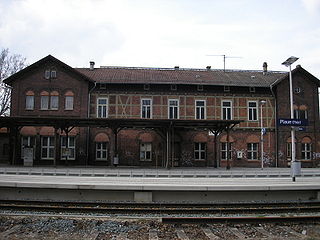
Plaue (Thür) station is a junction station in the town of Plaue in the German state of Thuringia.




















